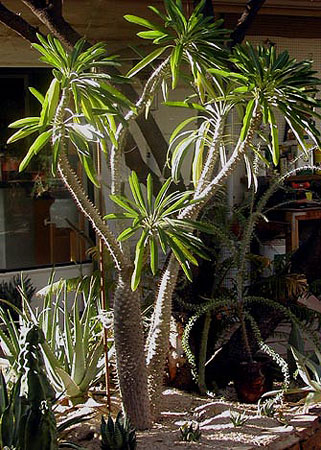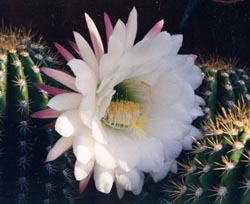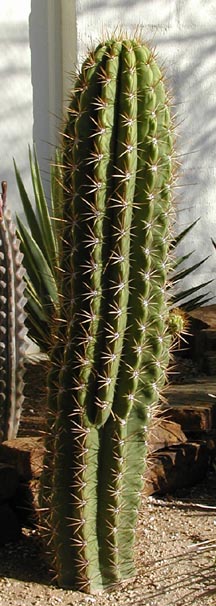
Agave desmetiana variegata
This plant is so versitale you would think its a gymnast. It can be used in formal planters for a Victorian look, masses for that modernist in all of us, accents in a rock garden, and even bold contrast in an English cottage garden. Standing alone is no problem for this guy. The arching leaves are bordered with a yellow stripe. The margins are barely toothed making it very user friendly. Scale-wise, it could not be more perfect, maxing out at 4 foot. The "pups" that form around the base can be pulled off, added to a planter, and then replanted in the garden after the parent blooms and dies.
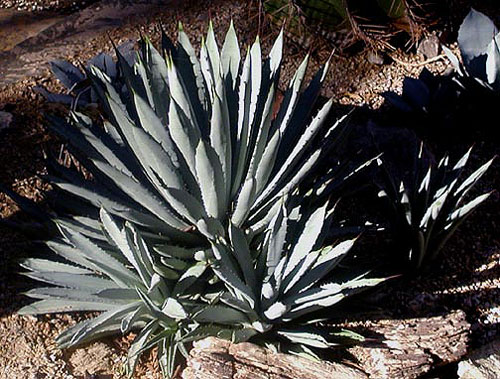
Agave macroacantha
Extremely drought tolerant agaves are common, but this one is among the best. This Agave forms a small rosette (looks best if you keep removing the pups) with blue leaves and black terminal spines. A few clonal types are available from California that are more bluegray, have thicker leaves, and decreased spination along the leaves.
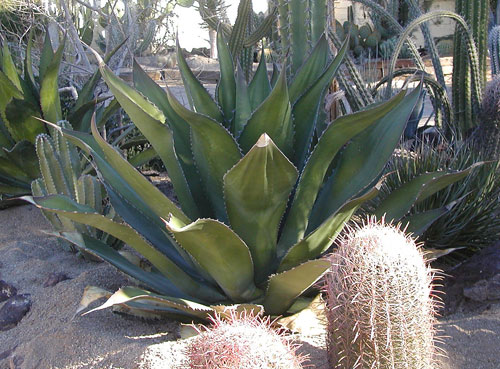
Agave salminiana
What a monster! I have seen it reach 7 feet high with leaves ten inches across. The broad spreading rosette needs room to grow, but what a magnificent plant. Give it some room, plant it in full sun, and watch it take off.
|
Alluadia procera
For sure, my absolute favorite! This plant is from the spine forest of Madagascar (lemur sold separately). In cultivation, it sort of twist and turns and sends up loads of branches in all directions. Kinda like Medusa, but friendlier. After numerous years, 5-20, it will send up one or two gigantic trunks ultimately reaching 20 feet in height. I have seen some in California with a 10" diameter. It is a smidge frost sensitive so don't plant it in the landscape if you are in a cold spot. Does great in full sun, in a pot, on a patio, in the landscape, etc.
|
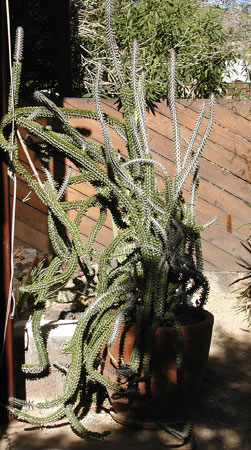
|
Aloe striata "Coral Aloe"
Although its been hybridized beyond record, coral aloes are amazing in or out of flower. The rosettes vary from broad spreading leaves (2-3 feet) in shade, to tight short leaves in sun. The margins of the leaves are pink, and in winter the plants take on a red hue lasting late into the spring. Afternoon shade helps take the stress of summer off, but I have grown them year round in full sun on a drip line and they perform great.

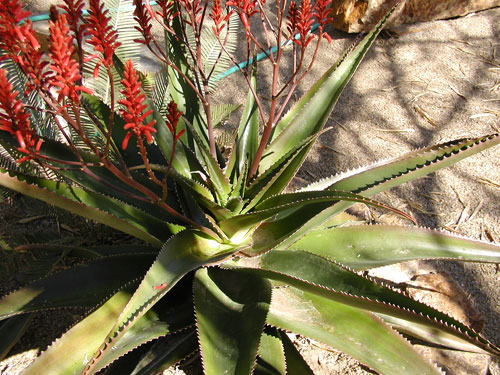
Aloe vaombe
Plant more of me! Its a toss up between these and Alluadias for my number one favorite plant, but hands down an underused plant. Sometimes its hard to come by, but keep searching for it. Even though the leaves are large and green, it can take full sun on a drip line. The trunk should be protected by allowing the old leaves to naturally curl down and cover the truck (forming a "skirt"). I have one with leaves 5 inches wide and 3 feet long. The overall trunk is up to 4 feet now. They reach a maximum size up around 12-15 feet. The blooms are one of the best aloes I have seen. As the plant matures 5-6, 2 foot flower stalks emerge in early winter. The flowers are bright red, last for weeks, and bring the hummingbirds coming back for more.
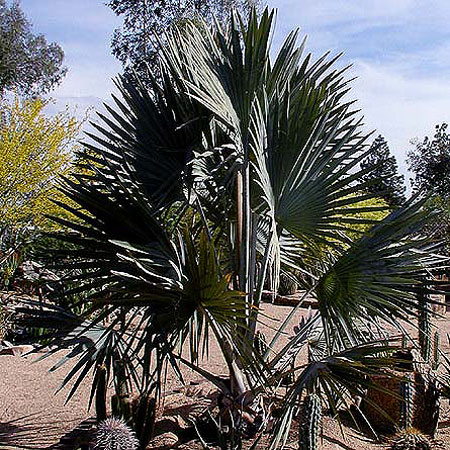
Bismarkia nobilis "Bismark Palm"
Arizona Grown and readily available here in the valley. Probably the biggest, boldest leaves you could use in a landscape. The leaves are 2-3 times that of a Mexican fan, powdery blue, and prominently folded. They take a tremendously long time to form a trunk, so the leaves are part of the landscape for many many years. Check it out and see what you think.

Dasylirion wheerleri "Desert Spoon"
Although very common and widely used, it's one of the staples of any native planting. The rosettes max out around 6 feet across, but then they slowly but surely form a trunk. Their blue hue and long leaves and great texture to the landscape. Lightly trim back leaves that touch the ground to maintain large globular appearance. Doing so makes yard maintenance much easier by decreasing the leaves that get trapped inside them. Don't over prune. We want wide spreading rosettes not 6 leaves on a trunk. Less is always more with pruning.
Dioon edule
Native to Central Mexico where it is also really hot and really dry, these prehistoric palms rock in Phoenix. Unfortunately since they grow about 1 meter of trunk per 500 years, it is really hard to find big ones. Grapefruit sized plants are available with some searching, but they are pricey. Smaller ones with a flush of leaves are stating to flood the market from California if you know whom to contact. hint hint. I found that afternoon shade helps in the dead of summer heat, but otherwise put them on the desert drip line and plant in bright light.
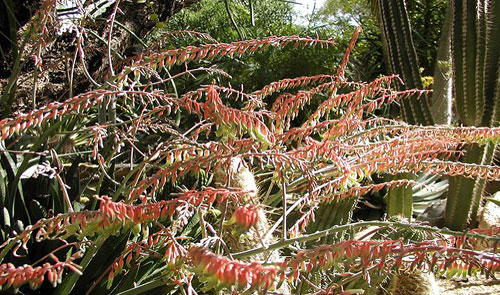
Gasteria acinacifolia
Tied for #3 on my list. I absolutely dig this plant. The individual rosettes grow to 2 foot across, but the plant can have as many as 50 heads at one time. Although after a few years at that size they will need divided. They must have filtered light. The summer sun burns their leaves and being a slow grower, they take a few years to grow out of it. High filtered light is good too because the winter sun mixed with low temps seem to turn Gasterias a beautiful red hue. When planted in pots, I tend to shift them to shade in summer, and high light in winter. The best thing though are the flowers. Hundreds of tiny flamingo heads line the 2 foot stalks. They are spectacular when flowering in masses.
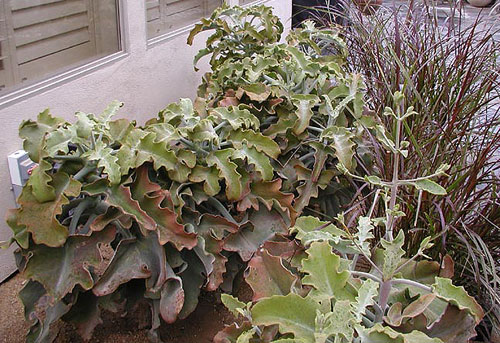
Kalanchoe beharensis
Tied with Gasteria acinacifolia for 3rd. A Madagascar native with huge, ruffled, furry leaves. Can take full morning to mid day sun with no problem on a dripline. This guy grows to 15 feet and has a corky, bonsai trunk. I have seen leaves in botanical gardens almost 2 feet long by a foot wide. Big down side is that it is really frost sensitive. Grows back after damage is done, but unsightly for a few months. Solution, plant in courtyards with canopies, big heavy pots on patios in bright light, or in the ground in warmer parts of the city. I have had success with it in Scottsdale, in preserves areas that are on slopes, and on covered patios. No luck at my house in central Phoenix. Freezes every year.
Livistonia decipiens "Ribbon Palm"
Fairly typical fan palm for shape, form, and height. The leaves are the dramatic part. They look like they were shredded by a cat on catnip. Long pieces hang from the ends in tatters. Very exotic looking. For a lush, tropical accent in any garden, this is a keeper. Hard to find specimens, but their are numerous websites with smaller sized plants available.
Opuntia macrocentra
As prickly pears go, this is the gem. Small, compact growth that is blue year round. In winter and when drought stressed the whole plant gets a pink hue. The spines are truly unique. They are black and 3 inches long, but the later half is white. This one barely needs a drop of water. In fact, when I have used drip on them, they get leggy, lose their great color, and fall apart. So to keep them dense, water heavily when they look dessicated (or every 20 days in summer if no rain). Oh yeah, the flowers are amazing. They look like roses with petals ranging from rose to yellow even on the same plant.
|
Phormium "New Zeland Flax"
The coolest, boldest annual ever. I am sure that, along with myself, other designers wish they were perennial in Phoenix like they are in San Diego. The foliage can reach 3 feet if a 5 gallon is planted as soon as available after Labor Day. They will live from late September until mid June, and then the summer heat gets them. The leaves vary by variety and are broad to narrow, mostly straight sword-like, and amazingly colored. My favorite is the bronze hued ones. They add the perfect accent to color pots, perennial gardens, patios, and pool areas. They rock in full sun, part sun, and even light shade. The colors of the leaves as the sun filters through them is outstanding. |
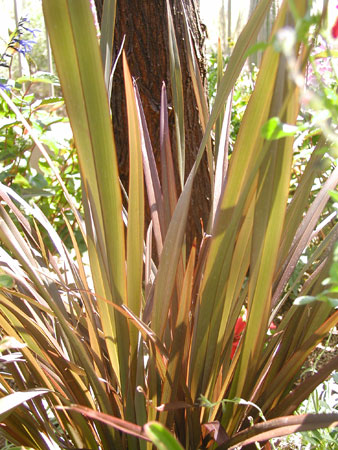
|
Portulacaria afra "Elephant's Food"
Common enough to show up in gas station planters, but don't let that fool you. In tough to establish areas, these are the ticket. They thrive in full sun, hanging pots, planters, confined spaces, and in shade. They are tough to kill, drought tolerant, and spineless. Older plants look great in bonsai dishes.
Sansvieria species
I think this genus has been under-rated for far too long. They are semi-tropical to drought tolerant. Some species can take almost full sun, while others enjoy shade. The leaves vary more greatly than the interior plant, "mother in law's tongue", we all know and love so well, also a Sansevieria. 'Mason Congo', 'Kirchii', and cylindrica and my favorite cultivars and species. They vary so greatly in cultivation that you just really need to try a few in different places and see how they perform. Their form is outstanding for masses, transitional walkways, zen gardens, and modern wok pots.
|











